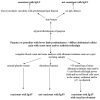New Insights and Challenges Associated With IgA Vasculitis and IgA Vasculitis With Nephritis-Is It Time to Change the Paradigm of the Most Common Systemic Vasculitis in Childhood?
- PMID: 35372148
- PMCID: PMC8965283
- DOI: 10.3389/fped.2022.853724
New Insights and Challenges Associated With IgA Vasculitis and IgA Vasculitis With Nephritis-Is It Time to Change the Paradigm of the Most Common Systemic Vasculitis in Childhood?
Abstract
What are the challenges ahead and how have we responded so far when it comes to the non-granulomatous systemic vasculitis, characterized mainly by deposits of IgA immune complexes in the endothelium of small blood vessels-IgA vasculitis (IgAV)? That is the question to which we tried to answer. We summarized existing knowledge about epidemiology, pathogenesis, genetics, diagnostic tests and therapy in this somewhat neglected entity in pediatric rheumatology. Since etiopathogenesis of IgA vasculitis is complex, with factors other than galactose-deficient IgA1-containing immune complexes also being important, and may involve numerous interactions between environmental and genetic factors, genomics alone cannot explain the entirety of the risk for the disease. The incidence of IgAV and nephritis varies worldwide and may be a consequence of overlapping genetic and environmental factors. In addition to the role of the HLA class II genes, some studies have pointed to the importance of non-HLA genes, and modern geostatistical research has also indicated a geospatial risk distribution, which may suggest the strong influence of different environmental factors such as climate, pathogen load, and dietary factors. The application of modern geostatistical methods until recently was completely unknown in the study of this disease, but thanks to the latest results it has been shown that they can help us a lot in understanding epidemiology and serve as a guide in generating new hypotheses considering possible environmental risk factors and identification of potential genetic or epigenetic diversity. There is increasing evidence that an integrative approach should be included in the understanding of IgA vasculitis, in terms of the integration of genomics, proteomics, transcriptomics, and epigenetics. This approach could result in the discovery of new pathways important for finding biomarkers that could stratify patients according to the risk of complications, without an invasive kidney biopsy which is still the gold standard to confirm a diagnosis of nephritis, even if biopsy findings interpretation is not uniform in clinical practice. Ultimately, this will allow the development of new therapeutic approaches, especially important in the treatment of nephritis, for which there is still no standardized treatment.
Keywords: IgA vasculitis; IgA vasculitis nephritis; clinical presentations; diagnostics; disease activity; epidemiology; pathogenesis; treatment.
Copyright © 2022 Jelusic, Sestan, Giani and Cimaz.
Conflict of interest statement
The authors declare that the research was conducted in the absence of any commercial or financial relationships that could be construed as a potential conflict of interest. The reviewer DP declared past co-authorships with one of the authors RC and the absence of any ongoing collaboration with any of the authors to the handling editor.
Figures




References
-
- Ozen S, Pistorio A, Lusan SM, Bakkaloglu A, Herlin T, Brik R, et al. . EULAR/PRINTO/PRES criteria for Henoch-Schonlein purpura, childhood polyarteritis nodosa, childhood Wegener granulomatosis and childhood Takayasu arteritis: Ankara 2008 Part II: final classification criteria. Ann Rheum Dis. (2010) 69:798–806. 10.1136/ard.2009.116657 - DOI - PubMed
Publication types
LinkOut - more resources
Full Text Sources
Research Materials
Miscellaneous

